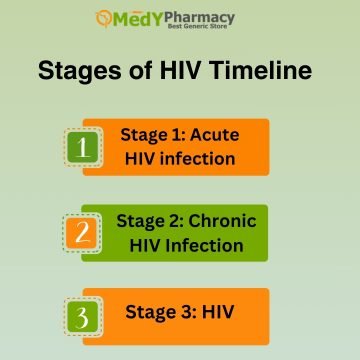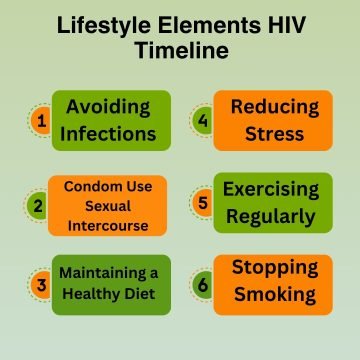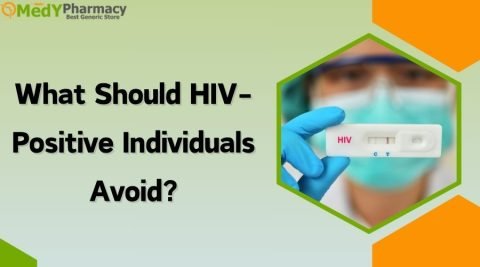Introduction:
This virus has an impact on the immune system. These cells aid in defending the body against infections.
Unless a person receives adequate, continuous treatment, this can cause lethal consequences by gradually weakening the body’s defences against infection and sickness. This is not always fatal as long as the patient is given the right care.
Antiretroviral medication can stop spreading this, particularly if taken early. When HIV patients receive this treatment, they can lead long, healthy lives. They have similar life expectancies to those who do not have HIV.
This page examines the symptom timeline, infection phases, and prognosis. It also explains ways to stop the spread of HIV.
If you or someone you love has HIV, knowing the basics and what to expect will help you and others you care about stay healthy. This has no known cure. However, a healthy life is possible thanks to efficient treatments.
If you do not receive HIV therapy or do not take your medications as directed, the infection will worsen over time. This often develops into AIDS after going through several stages if left untreated.
What is HIV?
The virus affects and kills CD4 T cells, which are white blood cells that typically aid the body in fending off infections from:
- Viruses
- Germs
- Fungus
If medication is not received, HIV continues to replicate and damages an increasing number of cells, weakening the immune system and making it incapable of fending off these infections.
Nonetheless, antiretroviral therapy is a medication that can drastically lower blood HIV levels.
There is almost no chance of spreading it to other people now.
Once someone develops HIV, the virus typically remains in their body for the rest of their lives. Nonetheless, these are distinct from those of other viral diseases in that they develop gradually.
There are three stages to the infection-induced illness if treatment is not received. Each may have unique problems and symptoms.
Regular antiretroviral therapy, however, can lower blood HIV levels to undetectable levels. This implies that the virus won’t advance to the later phases of HIV infection or spread to a sexual partner.
What relationship does the HIV life cycle have with HIV medications?
The treatment of HIV infection using a combination of these is known as antiretroviral therapy. Every day, people on ART take a mix of HIV medications. This works by inhibiting HIV at various stages of its life cycle, protecting the immune system. Various drug classes are created based on how well they combat HIV. A certain stage in the life cycle is the focus of each class of medication.
ART is particularly efficient at stopping HIV from spreading because there are at least two different classes included in an HIV treatment regimen.
Atavir 300 can help those living with the virus live longer, healthier lives.
Symptoms of HIV: What Are They?
There are three stages of HIV infection. It gradually worsens and eventually overwhelms your immune system if you don’t treat it. Your stage will determine the symptoms you experience.
This symptoms can be quite similar to those of other viral diseases. Your symptoms may differ from someone else’s if you have HIV. The length of time you have had HIV and other variables will affect your symptoms.
What Is Typically The First Indication Of HIV?
Symptoms of the virus can appear, although they are not a good indicator of infection. Some folks will not have any symptoms at all. Therefore, you should always get tested if you believe you are in danger, even if you don’t exhibit any of the usual symptoms of an illness.
This alone should not be used to determine your status. Even if you do exhibit HIV-related symptoms, it will be difficult to identify. This is because early this can be mistaken for the flu or a variety of other ailments.
How long before HIV symptoms appear?
Flu-like symptoms may appear in some persons 1-4 weeks after initial infection. A week or two is usually all that these last. We refer to this initial phase as acute or primary HIV infection. You might then experience no further symptoms for ten years or longer. This type of this is known as asymptomatic. Despite your good health, the virus remains active in your body. It’s still yours to gift to another person.
This puts you at risk for illnesses that a healthy body could prevent once it has caused significant damage to your immune system. When you have a symptomatic HIV infection, you begin to observe issues brought on by these “opportunistic” infections. Symptoms may be present, but they are caused by other infections or illnesses that you are more likely to contract while you have HIV.
AIDS-Defining Diseases:
- Text Message
- Cancer
- Tuberculosis (TB)
- Pneumonia
When detected early and treated immediately, the majority of HIV-positive individuals never develop late-stage HIV. Living well requires maintaining good health, which includes regular exercise, restful sleep and nutrition, quitting smoking, and taking care of your emotional health.
Initial Signs of Primary HIV
Acute HIV infection or acute retroviral syndrome (ARS) are other names for this stage.
Since it typically produces flu-like symptoms, someone in this stage may mistakenly believe they have HIV instead of a serious case of the flu or another viral illness. Among symptoms, fever is the most prevalent.
- Headaches
- Achy Throat
- Extreme Exhaustion
- Chills
- Discomfort In The Muscles
- Swelling In The Neck, Groin, Or Armpits Of The Lymph Nodes
- A Rash With Tiny Pimples That Is Painful And Red Or Discolored
- Mouth Thrush Or Ulcers
It may take two to four weeks following initial exposure for basic HIV symptoms to appear. They might go on for a few weeks. Some people might only experience symptoms for a few days, though.
Early-Stage Symptomlessness
ARS is prevalent after HIV infection. HIV.gov states that symptoms may not show up for ten years or more, so this isn’t always the case.
Even though the virus multiplies rapidly in the weeks following infection, early this typically only appears when cell damage is significant.
This does not imply that cases that do not exhibit symptoms are less severe or that an individual who does not exhibit symptoms cannot spread the virus to others.
This infection progresses through several phases. Symptoms may include cold or flu-like symptoms in the early stages following exposure. While HIV remains active in the body, this may go away on its own. Weight loss, exhaustion, and unexplained fevers are some of the symptoms that might occur when it progresses to a chronic infection.
The acute stage may not always be followed immediately by the chronic stage, which might occur at any point. AIDS, which is identified by the quantity of a certain type of white blood cell in the blood, can develop if this is not received.
Stages of HIV Timeline
This develops in three stages when an individual gets infected and does not get treatment.
Asking a healthcare practitioner about postexposure prophylaxis, a preventive medicine, is crucial for everyone who may have been exposed to HIV.
Preexposure prophylaxis can be taken regularly by those who are at risk of contracting HIV to stop the infection from spreading, even if exposure does happen.

Stage 1: Acute HIV infection
When an individual is exposed to HIV, the virus multiplies rapidly and is found in high concentrations in the blood.
- Blood
- Semen and Seminal Fluid
- Rectal Fluid
- Vaginal Fluid
- Breast Milk
Several days or weeks may pass during this time.
However, these symptoms are not present in everyone. This can spread without causing any symptoms if a person is not tested.
- Fever
- Muscle or Joint Pain
- Tiredness
- Night Sweats
- Skin Rashes
- Ulcers in the Mouth
- Sore Throat
- Swollen Glands
- Nausea or Vomiting
Together, these signs and symptoms are referred to as seroconversion sickness. To eradicate the virus, they symbolise the body’s normal reaction to an infection. However, once this is present, the human body cannot eradicate it.
Using the body’s CD4 T cells, the virus replicates at this point and spreads throughout the body. As a result, CD4 T cells are destroyed.
This process stabilizes in due course. The immune system lowers viral particle counts while increasing CD4 T cell counts. The quantity of these cells might not, however, revert to its initial level.
The virus replicates itself many times inside your body and spreads to every cell. Your CD4 cells, which are immune cells that combat infections, are attacked by the virus. The symptoms are brought on by the virus’s interaction with your immune system.
You currently have a high level of HIV in your blood. You can easily infect someone else with the virus as a result. Starting treatment as soon as you learn you have an acute this is a recommended strategy to control the illness.
Not all people experience symptoms at this point. Some suffer from minor flu-like symptoms that are often ignored. This implies that HIV can be acquired without awareness, which is why testing is crucial.
People who believe they may have been exposed to HIV should seek counsel from a healthcare provider and inquire about post-exposure prophylaxis, a prophylactic drug.
Tests for this can be ordered by medical experts. Tests for the virus must be administered 90 days after exposure, while others can identify it after 10 days. Individuals may need to take multiple tests to obtain reliable findings.
Stage 2: Chronic HIV Infection
The virus continues to be active after the acute phase has passed if the patient has not gotten therapy. Even though its reproduction is very modest, it nevertheless harms immune cells.
At this point, symptoms are typically either very mild or nonexistent. Doctors sometimes refer to stage 2 as “asymptomatic HIV infection” or “clinical latency” for this reason. Even if the virus doesn’t show any symptoms at this point, it can still spread to other people.
In the absence of treatment, this stage may continue for ten years or longer until the individual progresses to stage 3 HIV.
On the other hand, contemporary antiretroviral drugs can prevent the infection from spreading. The viral load, or amount of HIV in the body, is significantly reduced by these medications to extremely low levels.
This is unable to harm the immune system or spread to other individuals when the viral load is so low that tests are unable to identify it.
If successfully treated with antiretroviral medication, a person with stage 2 HIV may never become stage 3 HIV.
Clinical delay and the asymptomatic stage are other terms for this stage. You still have the virus in your body at this point, but it is not very strong. However, you can spread the infection to other people as long as the virus is present in detectable amounts.
If left untreated, this stage may last for ten years or more. Compared to others, some will worsen and go to the next stage more quickly. You may experience this period for a long time if you take medication. You might not ever advance to the next phase.
Stage 3: HIV
Phase 3 AIDS, another name for HIV, is the most severe stage. It happens when there is so much damage to the immune system that it is unable to combat infections.
Antiretroviral medication maintains a robust immune system that stops HIV from reaching this stage.
In the absence of therapy, the viral load keeps rising while the number of CD4 cells keeps declining. If a person’s CD4 cell count falls below 200 cells per cubic millilitre or they become infected with an opportunistic virus, they are diagnosed with stage 3 HIV.
Because they are typically caused by certain opportunistic diseases, symptoms at this stage can vary widely.
- Night Sweats
- Fever
- Persistent Cough
- Skin, Mouth, Or Both
- Regular Infections
- Chronic Diarrhea
- Weight Loss
Nowadays, opportunistic infections are becoming less frequent because of improved therapies. Although opportunistic infections come in a variety of forms, the following are some of the most prevalent in the US:
- Herpes
- Salmonella
- Candidiasis
- Toxoplasmosis
This can be managed with treatment, and people can recover from severe HIV-related infections and illnesses. Antiviral, antibiotic, and antifungal medications are used to treat infections.
Immediately seek treatment if you have AIDS. This can still be controlled with medication, and it can also help with other infections linked to AIDS. People with AIDS often live for three years if they don’t receive therapy.
Your immune system is weakened, which increases your vulnerability to infections and diseases. Additionally, the high viral concentration in your blood makes it very simple for you to infect someone else.
How to Determine Your HIV Status
It might be challenging to determine whether you have HIV based just on your symptoms because the virus frequently has non-specific signs.
A person may not become aware that they have HIV until they experience a major OI, such as tuberculosis, or a rare AIDS-defining illness, such as mycobacterium avium complex, because many of the initial symptoms are easily overlooked or mistaken for other, less dangerous causes.
The issue with this is that when treatment begins with CD4 counts below 200, it is far more difficult to restore the immune system. Even with treatment, a person may never return to normal when their CD4 count is less than 100 or 50.
In light of this, whether or not you exhibit symptoms, it is crucial to get tested if you have risk factors for HIV infection.
- Do you have any past experiences with condom-free sex?
- Currently suffering from or having previously experienced any other STI
- Using syringes, needles, or other drug paraphernalia together
In light of these risk factors, the U.S. Preventive Services Task Force (USPSTF) advises that all individuals aged 15 to 65 should undergo a one-time HIV test as part of a regular medical visit. Similarly, the CDC recommends one-time testing for anyone aged 13 to 64.
Centres for Prevention and Control of Disease. Recommendations for HIV clinical testing.
Regularly, this is advised for those who are at continuous risk, including injecting drug users, sexually active men who have sex with men, and those who have several sex partners.
How to Stop the Spread of HIV Timeline
Taking antiretroviral medicine as soon as feasible and as directed by a physician is the best method to prevent HIV from developing.
Antiretroviral medication maintains the immune system’s health. A person can start treatment sooner if they are diagnosed sooner. Early intervention can enhance the patient’s quality of life and reduce the likelihood that the virus will spread to other people.
- Antiretroviral Therapy
By stopping the virus from spreading, antiretroviral medication maintains the immune system’s health.
- Reduces the action of viruses
- Extends the lifespan and immunity of the individual
HIV levels in the blood are lowered to extremely low or undetectable levels when antiretroviral medication is taken. Within six months, the majority of patients on antiretroviral medications have their infection under control.
The danger of HIV transmission to others is almost zero after the viral load is undetectable.
A physician may modify the medication regimen for the patient. Consistently taking the drug as directed increases its effectiveness. Additionally, the likelihood of the virus becoming resistant to the treatment is decreased.
- PEP
PEP can help those who have recently been exposed to HIV stop it from spreading. This option is for emergencies.
When taken within 72 hours after suspected HIV exposure and as soon as possible, PEP is most effective. This can prevent HIV when someone does this.
Diagnoses and Tests of HIV
Anybody aged 13 to 64 should get tested for HIV at least once, according to the CDC.
People who may be at higher risk of HIV infection are recommended to get tested at least once annually.
- A person who was allocated at birth and has intercourse with other AMAB individuals
- Who share needles or syringes, have had anal or vaginal sex with someone who is HIV-positive or whose status is unknown, have recently received an STI diagnosis.
- Here is a local testing location.
Each of the several test types has a window period, or the interval between possible HIV exposure and the time at which a test can identify the virus. Using postexposure prophylaxis (PEP) can help stop the spread of HIV if you may have been exposed to the virus within the last 72 hours.
A can typically be identified by nucleic acid testing 10–33 days after exposure. There will also be a follow-up test to confirm a positive result.
It might be hard for some people to learn they have HIV. However, some medical personnel are available to offer both physical and mental support.
You might be sent to an expert HIV provider or receive direct assistance from your regular practitioner. An HIV-experienced local clinician might be found here as an alternative.
HIV and Adverse Reactions
When receiving treatment for HIV, some of your symptoms may be caused by the medications you’re taking. Entavir 1 medications can help you maintain your health while avoiding spreading the illness to others. But you might also experience adverse consequences.
Your current medication may have an impact on any side effects you experience. A few days or weeks may pass before any side effects disappear.
- Nausea
- Fatigue
- Sleep issues
There may be other adverse effects in the future. For example, some HIV medications may make you more susceptible to elevated cholesterol. Discuss potential side effects with your doctor if you are taking medication for HIV or other illnesses.
Lifestyle Elements HIV Timeline
Several lifestyle factors may contribute to HIV progression. An individual can implement tactics to strengthen their immune system,

- Avoiding Infections
Take precautions against infections and diseases, such as receiving routine immunisations as advised by a physician.
- Reducing Stress
The immune system deteriorates under stress.
- Condom Use Sexual Intercourse
Condoms shield HIV-positive individuals from other STDs that could compromise their immune systems.
- Exercising Regularly
A lower risk of heart disease, more energy, greater circulation and lung capacity, better sleep, and reduced stress are just a few advantages of regular physical activity.
- Maintaining a Healthy Diet
Eating a healthy, balanced diet and avoiding alcohol can strengthen the immune system and prevent infections. Eating a healthy diet can also improve the effectiveness of HIV treatment.
- Stopping Smoking
Smokers with HIV have an increased risk of contracting infections like pneumonia and candidiasis, as well as diseases including heart disease, chronic obstructive pulmonary disease (COPD), and several types of cancer.
How Much Time Can Someone With HIV Go Undiagnosed?
Symptoms of HIV might appear early. But they often resemble a lot of other viral diseases. Additionally, your symptoms should subside in a week or month. Advanced: this typically doesn’t appear for years. Testing is the only method to determine whether you have HIV and may unknowingly infect others.
Early Detection and Treatment Are Crucial
By stopping the advancement from one stage to the next and preventing AIDS, early diagnosis and ART treatment can preserve a nearly normal life expectancy.
Routine viral load and CD4 count testing aids in tracking the course of HIV and informs treatment choices.
How can one determine whether a person has HIV?
The only method to determine whether you or anyone else has this is to get an HIV test. Take precautions if you are concerned that you may be exposed to HIV or are at risk of contracting the virus. Use condoms properly. If you inject drugs, avoid using sterilised needles. Consult your physician about pre-exposure prophylaxis, which entails taking HIV medication to avoid infection.
If an individual with this has regular access to therapy and is taking their medication as directed, their prognosis is significantly impacted.
HIV-positive individuals can have a long, healthy life with a life expectancy similar to that of those without the virus if they receive regular antiretroviral treatment before the infection worsens.
Infections with viruses, bacteria, fungi, and parasites, as well as malignancies including aggressive cervical carcinoma and Medypharmacy, are symptoms of later-stage HIV and AIDS.
























